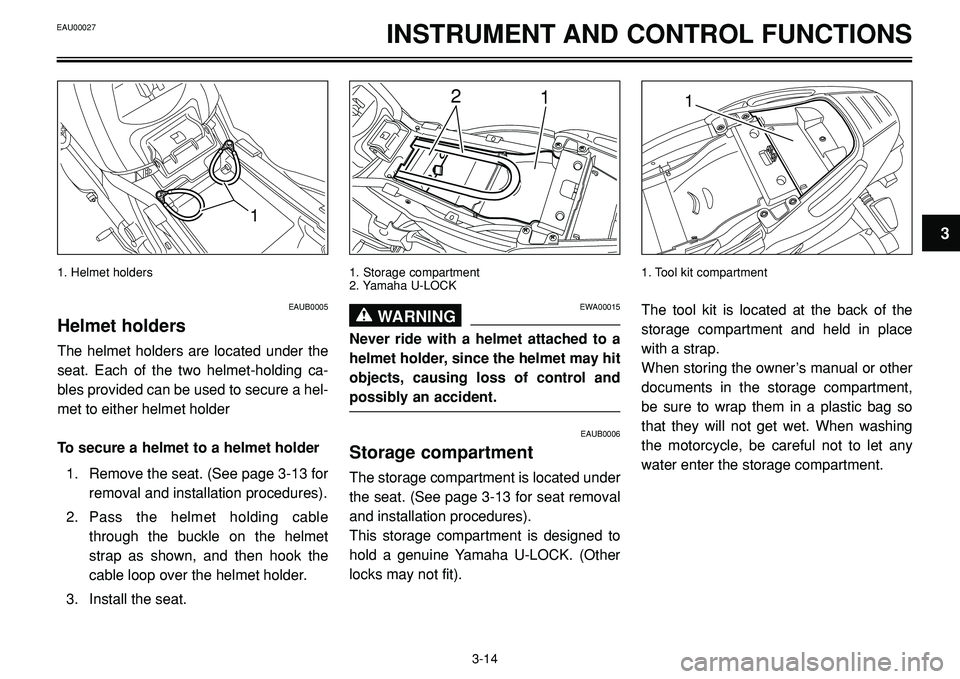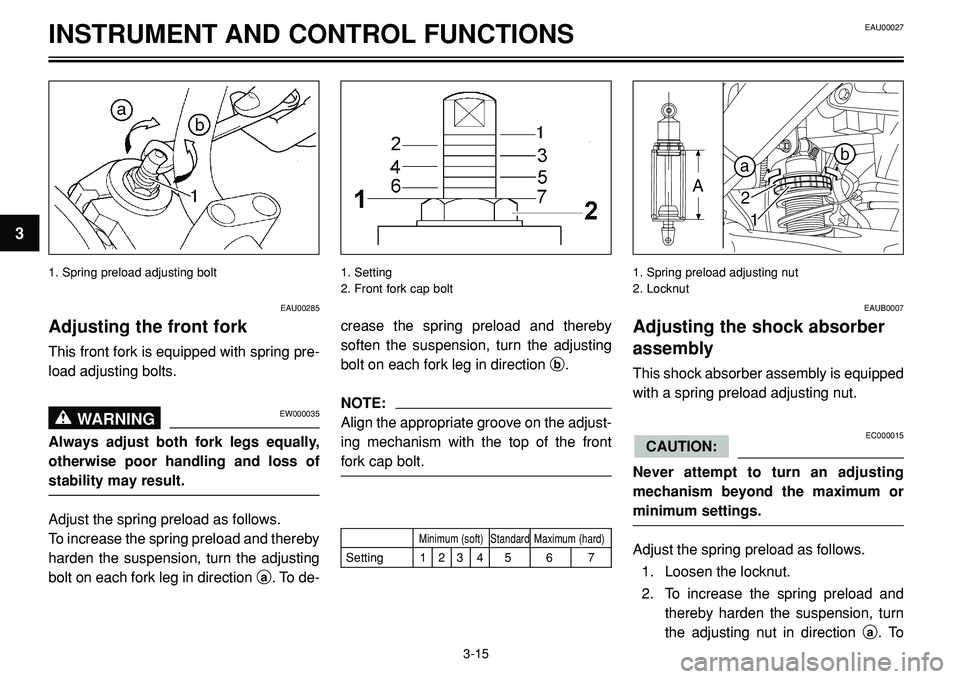Page 19 of 96

INSTRUMENT AND CONTROL FUNCTIONS
NOTE:
The clock can only be set when the motor-
cycle is stopped. The clock does not auto-
matically adjust for Daylight Saving Time.
Therefore, when the time changes from
Standard Time to Daylight Saving Time
(and vice versa), the clock must be set
manually.
EAU00101
Tachometer
The electric tachometer allows the rider to
monitor the engine speed and keep it with-
in the ideal power range.
EC000003
Do not operate the engine in the
tachometer red zone.
Red zone: 6,400 r/min and above.
CAUTION:
EAUB0004
Self-diagnosis device
NOTE:
When the key is turned to “
I” (ON), the
tachometer and speedometer needles
should move to the maximum, then back
to zero. In addition, the oil level warning
light and fuel level warning light should
come on for a few seconds, then go off. If
the tachometer or speedometer needle
does not move as described or either of
the warning lights does not come on, have
a Yamaha dealer check the electrical cir-
cuits.
This model is equipped with a self-diagno-
sis device for the following electrical cir-
cuits:
•speedometer
•tachometer
•oil level warning light
•throttle position sensor
•speed sensor.
3-6
31
2
1. Tachometer
2. Red zone
EAU00027
Page 24 of 96

INSTRUMENT AND CONTROL FUNCTIONS
1
2
1
2
EAU02935
Fuel tank cap
To open the fuel tank cap
Open the fuel tank cap lock cover, insert
the key into the lock, and then turn it 1/4
turn clockwise. The lock will be released
and the fuel tank cap can be opened.To close the fuel tank cap
1. Push the fuel tank cap into position
with the key inserted in the lock.
2. Turn the key counterclockwise to the
original position, remove it, and then
close the lock cover.
NOTE:
The fuel tank cap cannot be closed unless
the key is in the lock. In addition, the key
cannot be removed if the cap is not prop-
erly closed and locked.
EWA00025WARNING0
Make sure that the fuel tank cap is
properly closed before riding.
EAU03753
Fuel
Make sure that there is sufficient fuel in the
tank. Fill the fuel tank to the bottom of the
filler tube as shown.
EW000130WARNING0
•Do not overfill the fuel tank, other-
wise it may overflow when the fuel
warms up and expands.
•Avoid spilling fuel on the hot
engine.
3-11
3
1. Lock cover
2. Open1. Fuel tank filler tube
2. Fuel level
EAU00027
Page 27 of 96

1
3
INSTRUMENT AND CONTROL FUNCTIONS
1. Helmet holders
12
1. Storage compartment
2. Yamaha U-LOCK
1
1. Tool kit compartment
EAUB0005
Helmet holders
The helmet holders are located under the
seat. Each of the two helmet-holding ca-
bles provided can be used to secure a hel-
met to either helmet holder
To secure a helmet to a helmet holder
1. Remove the seat. (See page 3-13 for
removal and installation procedures).
2. Pass the helmet holding cable
through the buckle on the helmet
strap as shown, and then hook the
cable loop over the helmet holder.
3. Install the seat.
EWA00015WARNING0
Never ride with a helmet attached to a
helmet holder, since the helmet may hit
objects, causing loss of control and
possibly an accident.
EAUB0006
Storage compartment
The storage compartment is located under
the seat. (See page 3-13 for seat removal
and installation procedures).
This storage compartment is designed to
hold a genuine Yamaha U-LOCK. (Other
locks may not fit).
The tool kit is located at the back of the
storage compartment and held in place
with a strap.
When storing the owner’s manual or other
documents in the storage compartment,
be sure to wrap them in a plastic bag so
that they will not get wet. When washing
the motorcycle, be careful not to let any
water enter the storage compartment.
3-14
EAU00027
Page 28 of 96

INSTRUMENT AND CONTROL FUNCTIONS
1. Spring preload adjusting bolt 1. Setting
2. Front fork cap bolt
��
�
� �
1. Spring preload adjusting nut
2. Locknut
EAU00285
Adjusting the front fork
This front fork is equipped with spring pre-
load adjusting bolts.
EW000035WARNING0
Always adjust both fork legs equally,
otherwise poor handling and loss of
stability may result.
Adjust the spring preload as follows.
To increase the spring preload and thereby
harden the suspension, turn the adjusting
bolt on each fork leg in direction a. To de-
crease the spring preload and thereby
soften the suspension, turn the adjusting
bolt on each fork leg in direction b.
NOTE:
Align the appropriate groove on the adjust-
ing mechanism with the top of the front
fork cap bolt.
EAUB0007
Adjusting the shock absorber
assembly
This shock absorber assembly is equipped
with a spring preload adjusting nut.
EC000015
Never attempt to turn an adjusting
mechanism beyond the maximum or
minimum settings.
Adjust the spring preload as follows.
1. Loosen the locknut.
2. To increase the spring preload and
thereby harden the suspension, turn
the adjusting nut in direction a. To
CAUTION:
3-15
3
EAU00027
Minimum (soft) Standard Maximum (hard)
Setting 1 2 3 4 5 6 7
Page 29 of 96

INSTRUMENT AND CONTROL FUNCTIONS
decrease the spring preload and
thereby soften the suspension, turn
the adjusting nut in direction b.
NOTE:
Use the special wrench included in the
owner’s tool kit to make the adjustment.
The spring preload setting is determined
by measuring distance A, shown in the
illustration. The longer distance A is, the
higher the spring preload; the shorter dis-
tance A is, the lower the spring preload.
With each complete turn of the adjusting
nut, distance A changes by 1.5 mm.3. Tighten the locknut to the specified
torque.• Always have a Yamaha dealer ser-
vice the shock absorber.
EAU00330
Sidestand
The sidestand is located on the left side of
the frame. Raise the sidestand or lower it
with your foot while holding the motorcycle
upright.
NOTE:
The built-in sidestand switch is part of the
ignition circuit cut-off system, which cuts
the ignition in certain situations. (See fur-
ther down for an explanation of the ignition
circuit cut-off system).
3-16
3
Spring preload:
Minimum (soft):
Distance A = 170 mm
Standard:
Distance A = 162 mm
Maximum (hard):
Distance A = 154 mm
Tightening torque:
Locknut:
45 Nm (4.5 m•kg)
EAU00315WARNING0
This shock absorber contains highly
pressurized nitrogen gas. For proper
handling, read and understand the fol-
lowing information before handling the
shock absorber. The manufacturer can-
not be held responsible for property
damage or personal injury that may
result from improper handling.
•Do not tamper with or attempt to
open the gas cylinder.
•Do not subject the shock absorber
to an open flame or other high heat
sources, otherwise it may explode
due to excessive gas pressure.
•Do not deform or damage the gas
cylinder in any way, as this will
result in poor damping perfor-
mance.
EAU00027
Page 30 of 96

INSTRUMENT AND CONTROL FUNCTIONS
EW000044WARNING0
The motorcycle must not be ridden
with the sidestand down, or if the side-
stand cannot be properly moved up (or
does not stay up), otherwise the side-
stand could contact the ground and
distract the operator, resulting in a pos-
sible loss of control.
Yamaha’s ignition circuit cut-off sys-
tem has been designed to assist the
operator in fulfilling the responsibility
of raising the sidestand before starting
off. Therefore, check this system regu-
larly as described below and have a
Yamaha dealer repair it if it does not
function properly.
EAU03720
Ignition circuit cut-off system
The ignition circuit cut-off system (com-
prising the sidestand switch, clutch switch
and neutral switch) has the following func-
tions.
•It prevents starting when the trans-
mission is in gear and the sidestand
is up, but the clutch lever is not
pulled.
•It prevents starting when the trans-
mission is in gear and the clutch lever
is pulled, but the sidestand is still
down.
•It cuts the running engine when the
transmission is in gear and the side-
stand is moved down.Periodically check the operation of the ig-
nition circuit cut-off system according to
the following procedure.
EW000045WARNING0
If a malfunction is noted, have a Yamaha
dealer check the system before riding.
3-17
3
EAU00027
Page 35 of 96
PRE-OPERATION CHECKS
NOTE:
Pre-operation checks should be made each time the motorcycle is used. Such an inspection can be accomplished in a very short time;
and the added safety it assures is more than worth the time involved.
EWA00033WARNING0
If any item in the Pre-operation check list is not working properly, have it inspected and repaired before operating the motor-
cycle.
EAU01114
4-3
4
Page 37 of 96

OPERATION AND IMPORTANT RIDING POINTS
EAU00373WARNING0
•Become thoroughly familiar with
all operating controls and their
functions before riding. Consult a
Yamaha dealer regarding any con-
trol or function that you do not
thoroughly understand.
•Never start the engine or operate it
in a closed area for any length of
time. Exhaust fumes are poiso-
nous, and inhaling them can cause
loss of consciousness and death
within a short time. Always make
sure that there is adequate ventila-
tion.
•Before starting out, make sure that
the sidestand is up. If the side-
stand is not raised completely, it
could contact the ground and dis-
tract the operator, resulting in a
possible loss of control.
EAU03818
Starting the engine
In order for the ignition circuit cut-off sys-
tem to enable starting, one of the following
conditions must be met:
•The transmission is in the neutral po-
sition.
•The transmission is in gear with the
clutch lever pulled and the sidestand
up.
EW000054WARNING0
•Before starting the engine, check
the function of the ignition circuit
cut-off system according to the
procedure described on page 3-18.
•Never ride with the sidestand
down.
1. Turn the key to “I” (ON) and make
sure that the engine stop switch is set
to “
I”.
EC000035
If the fuel level warning light comes on,
check the fuel level, and, if necessary,
refuel as soon as possible.
2. Shift the transmission into the neutral
position.
When the transmission is in the neu-
tral position, the neutral indicator light
should be on, otherwise have a
Yamaha dealer check the electrical
circuit.
3. Turn the starter (choke) on and com-
pletely close the throttle. (See page
3-12 for starter (choke) operation).
CAUTION:
5-1
5
EAU00372